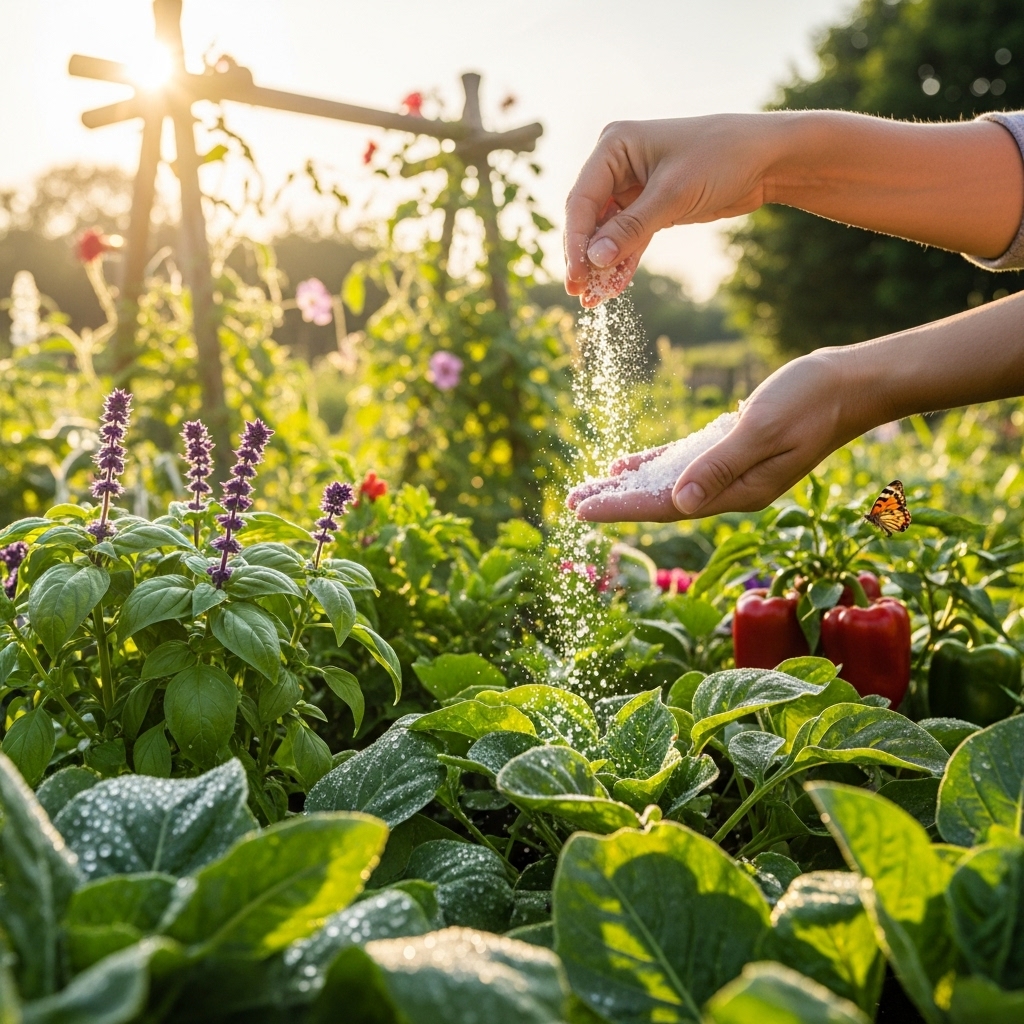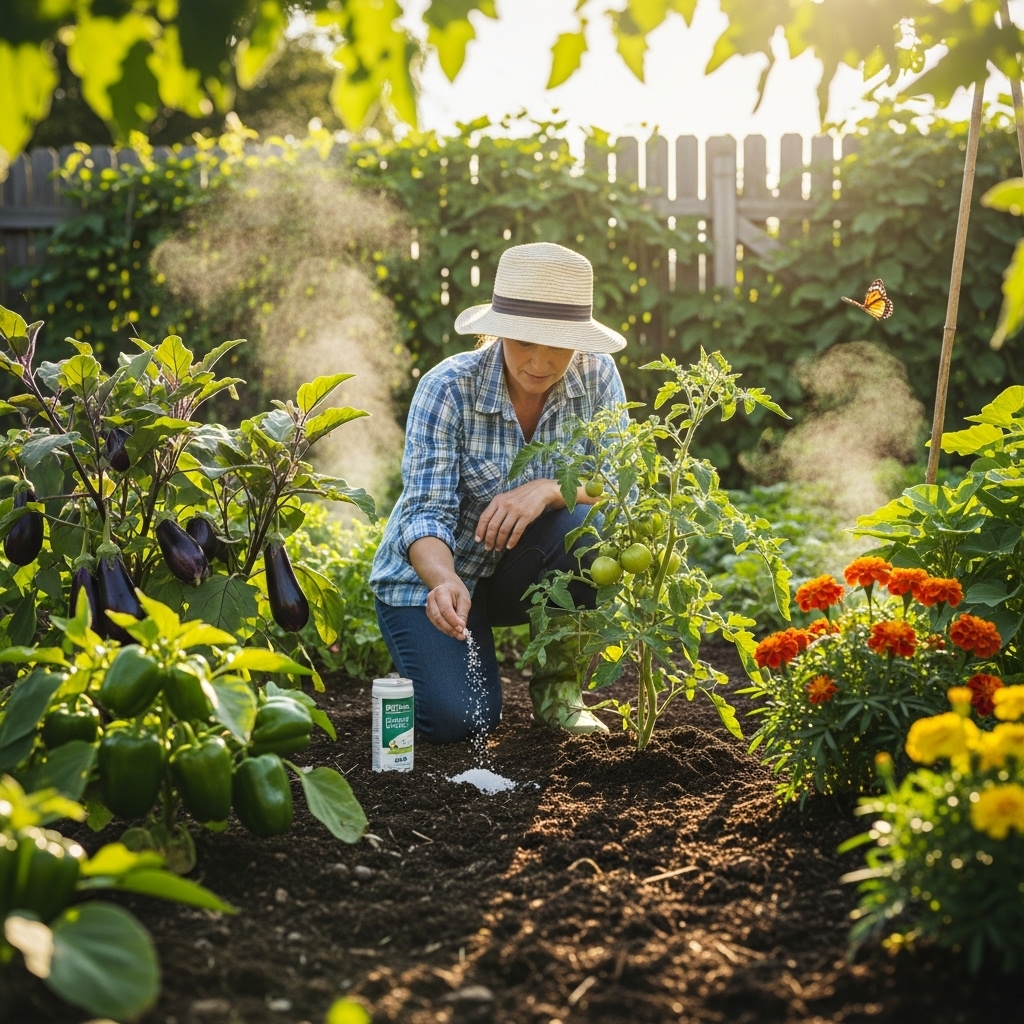As a passionate gardener, I’ve discovered that Epsom salt is an underappreciated gem. This simple compound transforms my garden, delivering benefits that go beyond mere aesthetics. Allow me to share why this secret weapon deserves a spot in your gardening toolkit.
The Science Behind Epsom Salt

When I first heard about Epsom salt, I assumed it was just another gardening fad. But as I delved deeper, I uncovered fascinating scientific properties that make it a valuable addition to any garden. Epsom salt, chemically known as magnesium sulfate, consists of magnesium, sulfur, and oxygen. Each of these elements plays a crucial role in plant health, and I can attest to the transformative effects they have in my own garden.
Magnesium: The Unsung Hero
Magnesium is often overlooked, yet it is an essential nutrient for plants. It contributes to photosynthesis, the process by which plants convert sunlight into energy. When I started incorporating Epsom salt into my gardening routine, I noticed a remarkable improvement in the vigor of my plants. Magnesium helps to enhance the chlorophyll in leaves, leading to deeper green foliage and more robust growth.
One of the most striking examples from my garden was with my tomato plants. Initially, they struggled to produce fruit, and their leaves displayed signs of yellowing—a clear indication of magnesium deficiency. After applying Epsom salt around the base of the plants, I witnessed a remarkable turnaround. Within weeks, the leaves regained their vibrant green color, and the plants became laden with juicy tomatoes. I found that magnesium not only improved the health of the plants but also boosted their overall yield.
Sulfur: The Secret to Flavor
Sulfur, another vital component of Epsom salt, is equally important for plant growth. It aids in the synthesis of proteins and enzymes, which are essential for healthy plant development. When I learned that sulfur can enhance the flavor profile of certain crops, I was intrigued. My experience with garlic and onions proved this point. By adding Epsom salt to the soil, I noticed that these crops displayed not only better growth but also a more robust flavor.
In my herb garden, I’ve found that basil and parsley also responded favorably to Epsom salt. The leaves became lush and aromatic, enhancing my culinary creations. It’s rewarding to know that a simple addition to the soil can elevate the taste of the foods I grow.
Improving Nutrient Uptake
One of the lesser-known benefits of Epsom salt is its ability to improve nutrient uptake in plants. I often struggled with giving my plants the right balance of nutrients, but Epsom salt has changed the game for me. Magnesium helps to bolster the uptake of other essential nutrients, such as nitrogen and phosphorus. This means that my plants can absorb these nutrients more effectively, leading to healthier growth overall.
For example, when I started using Epsom salt in conjunction with organic fertilizers, I noted a significant difference in plant performance. The combination of nutrients worked harmoniously, and my garden began to flourish. The blooms on my flowering plants became more vibrant, while my vegetable crops yielded more produce than ever. This synergistic effect is something I can’t overlook, and it has encouraged me to continue experimenting with Epsom salt in new ways.
Application Tips for Epsom Salt
Now that I’ve shared the science behind Epsom salt and its benefits, you might be wondering how to apply it effectively in your garden. I’ve found that the method of application can significantly impact the results. Here are some of my go-to techniques:
- Soil Amendment: I mix Epsom salt directly into the soil before planting. For most garden plants, I use about one tablespoon per square foot of soil. This ensures that the magnesium and sulfur are readily available to the roots as they establish.
- Liquid Solution: I also create a liquid solution by dissolving two tablespoons of Epsom salt in a gallon of water. This can be used as a foliar spray or a soil drench. I find that applying this solution every few weeks helps maintain nutrient levels throughout the growing season.
- Targeted Application: For specific plants that show signs of magnesium deficiency—like yellowing leaves—I sprinkle Epsom salt directly around their base. This targeted approach allows the plants to absorb the nutrients quickly and efficiently.
Incorporating Epsom salt into my gardening routine has truly been a game-changer. The science is compelling, and the results have been nothing short of impressive. As I continue to explore the many benefits of this simple compound, I can’t help but feel excited about what lies ahead in my garden. Stay tuned as I delve deeper into how Epsom salt can transform specific plants and gardening techniques in the next part of this article.
Using Epsom Salt with Specific Plants

As I’ve continued to experiment with Epsom salt in my garden, I’ve discovered that certain plants truly thrive when they receive this magical compound. It’s fascinating to see how different species react to the same treatment, and I’ve compiled a list of my favorites that have shown remarkable improvements thanks to Epsom salt.
Tomatoes: A Love Affair with Epsom Salt
My love for tomatoes runs deep, and I’ve learned that Epsom salt can be a game-changer for these beloved fruits. Beyond the initial success I experienced with my tomato plants, their performance continued to impress me each growing season. By applying Epsom salt at the time of planting and during their growth stages, I’ve noticed that my tomatoes not only produce more fruit, but the size and flavor are enhanced as well.
I often mix Epsom salt into the planting hole when I transplant my seedlings. This gives them a solid start, and as they grow, I make it a point to apply the liquid solution every few weeks. The result? Juicy, vibrant tomatoes that have become the highlight of my summer salads and sauces. I can’t emphasize enough how this simple addition has elevated my tomato gardening experience.
Peppers: Enhancing Color and Flavor
Peppers are another crop that greatly benefits from Epsom salt. I’ve had a variety of peppers in my garden, from sweet bell peppers to fiery jalapeños, and Epsom salt seems to enhance the color and flavor of each type. Just like tomatoes, I apply it during planting and continue to use the liquid solution throughout the season.
One year, I decided to conduct an informal experiment by growing two batches of the same pepper variety: one with Epsom salt and one without. The difference was astonishing! The peppers treated with Epsom salt not only had a deeper color but also a noticeably sweeter flavor. I was thrilled to share these peppers with friends and family, who couldn’t believe how much better they tasted. This experience solidified my belief in the power of Epsom salt.
Roses: A Blooming Success
As a lover of flowers, I couldn’t resist experimenting with Epsom salt on my roses. I’ve always been captivated by their beauty, but I wanted to take their health and vibrancy to the next level. After reading about the benefits of magnesium for flowering plants, I decided to add Epsom salt to my rose care routine.
I mix Epsom salt into the soil during spring when I’m preparing my rose beds. Additionally, I apply the liquid solution as a foliar spray while the buds are forming. The difference is remarkable! My roses have larger, more colorful blooms, and they seem to last longer in the vase. It’s incredibly rewarding to see my efforts rewarded with such stunning flowers that brighten up my home.
Houseplants: A Little TLC
I’ve also started applying Epsom salt to my indoor plants. I often struggled with keeping my houseplants healthy and vibrant, particularly those that seemed to lose their luster over time. Once I began using Epsom salt, I noticed a significant improvement in their overall appearance.
For my leafy houseplants, I use the liquid solution every few weeks. The results have been astonishing! My fiddle leaf fig and snake plants have shown renewed vigor. They’ve developed richer, greener leaves, and I can see new growth emerging. It’s as if Epsom salt has given them the extra boost they needed to thrive indoors.
Fruit Trees: Nurturing Nature’s Sweetness
One of my favorite gardening projects has been nurturing fruit trees, and Epsom salt has played a vital role in their development. I’ve applied it to my apple and peach trees, and the effects have been astounding. By incorporating Epsom salt into the soil at the start of the growing season, I’ve witnessed improved fruit quality and quantity.
Not only have the trees produced larger, juicier fruits, but I’ve also noticed that they’re more resilient against pests and diseases. The magnesium in Epsom salt seems to fortify their defenses, allowing them to thrive despite occasional challenges. It’s been immensely satisfying to harvest fruit from my own trees, knowing that Epsom salt played a part in their success.
As I continue to explore the wonders of Epsom salt in my garden, I’m excited about the possibilities ahead. The diverse applications and benefits of this simple compound have made a tremendous difference in my gardening journey, and I can’t wait to share more insights and techniques in the next section of this article.
Exploring Other Uses for Epsom Salt in the Garden

As I dive deeper into my gardening adventures with Epsom salt, I’ve discovered even more creative ways to utilize this remarkable compound beyond just enhancing individual plants. Its versatility has opened up a world of possibilities, and I’m excited to share some unique applications that have made a significant impact in my garden.
Weed Control
Weeds can be a gardener’s worst nightmare, and I’ve tried numerous methods to keep them at bay. Recently, I stumbled upon the idea of using Epsom salt as a natural weed killer. It turns out that the magnesium sulfate can be effective in controlling undesirable plants without harming the surrounding soil or beneficial organisms.
To put this method to the test, I mixed a solution of Epsom salt with water—a ratio of two tablespoons per gallon—and applied it directly onto the leaves of the weeds. I was amazed to see how quickly the weeds wilted and began to die off. This method not only helped me manage the weed population but also kept my garden safe from harsh chemicals. It’s a win-win that I’m thrilled to incorporate into my weed management strategy.
Enhancing Compost
Composting has become an integral part of my gardening routine, and I always look for ways to enhance the quality of my compost. I recently discovered that adding Epsom salt to my compost pile can improve its nutrient profile. The magnesium and sulfur from the salt enrich the compost, contributing to healthier plants when I eventually use it in my garden.
Whenever I add kitchen scraps or yard waste to my compost bin, I sprinkle in a handful of Epsom salt. I’ve noticed that the compost breaks down more efficiently and produces a nutrient-rich amendment that my plants adore. This simple addition has not only improved the composting process but has also given my plants a powerful boost when I apply the finished product.
Improving Soil Structure
Another fascinating use of Epsom salt that I’ve embraced is its ability to improve soil structure. Healthy soil is the foundation of a thriving garden, and incorporating Epsom salt can play a role in enhancing its texture and aeration. This is particularly beneficial in clay-heavy soils that can become compacted and difficult for roots to penetrate.
When I prepare my garden beds, I mix Epsom salt into the soil along with organic matter like compost or well-rotted manure. I’ve found that this combination helps to break up the clay, allowing for better drainage and root development. My plants have responded positively to this improved soil structure, leading to healthier growth and increased resilience against drought and disease.
Deterring Pests Naturally
In my ongoing battle against garden pests, I’ve turned to Epsom salt as a natural deterrent. Some pests, like slugs and snails, are notorious for wreaking havoc on tender plants, but Epsom salt can help keep them at bay. The salt creates an inhospitable environment for these creatures, making my garden less attractive to them.
I’ve sprinkled a thin line of dry Epsom salt around the perimeter of my garden beds. This barrier effectively discourages slugs and snails from crossing it, allowing my plants to thrive without being ravaged. I appreciate that this method is both effective and environmentally friendly, aligning with my commitment to sustainable gardening practices.
Watering with Epsom Salt for Seasonal Health
During particularly dry spells or when transitioning between seasons, I find that giving my plants a boost with an Epsom salt solution can be incredibly beneficial. This technique has been particularly helpful in the late summer when my garden needs extra care to withstand the heat.
I prepare a solution similar to the one I use for foliar applications—two tablespoons of Epsom salt dissolved in a gallon of water—and I water my plants with it every few weeks. This not only provides them with essential nutrients but also helps to improve their overall health as they prepare for the upcoming fall. I’ve noticed that my plants remain vibrant and resilient even during challenging weather conditions.
Future Experiments with Epsom Salt
As I look ahead, I’m excited about the possibilities that further experimentation with Epsom salt holds. I’ve read about its potential benefits for other crops, such as carrots and zucchini, and I can’t wait to put these ideas into practice. The journey of discovery in my garden is ongoing, and I relish the opportunity to refine my techniques and observe the outcomes.
Moreover, I’m eager to share my findings with fellow gardeners in my community. Collaborating and exchanging ideas fuels my passion for gardening, and Epsom salt has become a central topic of conversation in my circles. It’s rewarding to inspire others to explore this simple compound and witness the positive changes in their gardens.
Through all these experiences, Epsom salt has proven itself to be more than just a gardening aid; it’s a vital part of my gardening philosophy that emphasizes sustainability, health, and creativity. I’m thrilled to continue this journey, discovering new ways to harness the power of Epsom salt and enhance my garden’s vitality.
